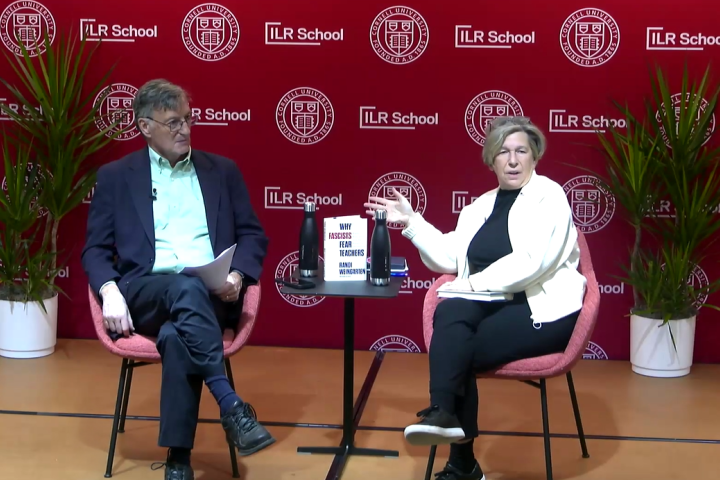
Patient Centered Collective Bargaining (Part One)
By John August/Director of Healthcare and Partner Programs at the Scheinman Institute
It is critically important to understand how difficult it is in the U.S. for labor and management to evolve to a collective bargaining relationship that reflects the world around them in ways that are beneficial to them and to the communities in which they live. After decades of transformation of the economic, social, demographic, public policy, technological, financial, and competitive landscape, for collective bargaining to remain relevant, it must also transform.
With this month’s entry into the Scheinman Institute newsletter and BLOG, I begin a series of entries that will draw on nearly two decades of direct experience with unions, healthcare systems, leadership from labor and management, and the engagement with frontline workers, managers, and physicians. I hope that these experiences and efforts will bring some definitional clarity and real-life interest for readers to pursue the strategy of what I call: “Patient-Centered Collective Bargaining”.
This is a very important topic in all sectors of the economy today and for the foreseeable future. We are living through a time when more and more people in the nation are living a life of economic vulnerability. We are also seeing rising movements among workers in many sectors who are looking for non-traditional solutions to their economic status: regulated solutions, such as living wages through the efforts of the fast food workers, retail, and similar campaigns in many other low-income industries.
There is the high profile organizing campaign at Amazon. Regardless of the outcome, the effort is a strong indication that previously “untouchable” companies and industries will face conflict over their role in that pervasive economic vulnerability.
These movements and responses to them are developing alongside the growing recognition that the nation’s physical infrastructure must be repaired; that public services and public education must be improved, and our health care system must expand access to all, improve the population’s health and substantially reduce the cost of that care.
Retirement security is a crisis that impacts nearly all Americans. And how we develop and use energy may become the largest collective problem for social engagement in history.
It is a time of great opportunity and necessity for new kinds of dialogue, dialogue that ought to include collective bargaining as a long-standing institution for social progress.
Will this be the case?
It is an exciting time to look to experience and experimentation in innovative collective bargaining. Where is there progress and why?
In the decades I led dozens of organizing campaigns, I always urged organizers to go to lunchrooms, not to talk, but to listen. That’s where the day-to-day of work is discussed, where the problems are exposed, everything from issues of fairness, to judgments about how best to produce the best outcomes for customers. And if you listen, you can frame.
We must consider that the concept of “framing” as essential to understand how to break through to innovations in collective bargaining and social dialogue more broadly. “The test of a good frame is, therefore the very practical one that people actually join in our cause – moving from bystanders, fence-sitters, free-riders, or opponents, to supporters.
People need to feel both aggrieved about some aspects of their lives and optimistic that, by acting collectively, they redress the problem. If one or both of these perceptions is lacking, it is highly unlikely that people will mobilize even when given the opportunity to do so.” (Bibby, Bevan, Carter, Bate, and Robert, The Power of One, The Power of Many, NHS Institute for Innovation and Improvement, 2009, page 63).
There is ample literature about how to transform organizations. There are substantial research projects, studies, books, articles, seminars of all kinds that provide the information necessary to help organizations and people build roadmaps for progress.
Yet, progress is slow in innovative collective bargaining. This lack of innovation is likely a factor in organizational change needed across many sectors of the economy where unions have a presence.
There is much to learn.
When I began my leadership role in the Labor Management Partnership (LMP) at Kaiser Permanente in 2006, progress was at a crossroads at the same time that the health care industry was on the precipice of fundamental transformation.
Simply put, all the elements of being able to predict where the health care industry was going at that time were evident. What can we learn from the evolution of the Kaiser Permanente LMP as it had to adapt to the emerging changes in care models and health care financing in the run-up to the Affordable Care Act and beyond?
The dialogue between the parties was changing.
The dialogue was changing from a dialogue between two parties, but adding focus on another: the patient!
In June, 2007, six frontline union member health care workers who worked every day in hospitals or clinics at Kaiser Permanente facilities and I entered the Ryhov Hospital in Jonkoping County, Sweden. We were a bit jet lagged. We struggled to get some sleep during the nearly 24 hours of daylight in this far northern geography.
We felt as though we were in another world.
Our delegation also included two high level KP executives, but the largest part of the contingent were the six union members. None were shy, all were eager to learn. All were active participants in the Labor-Management Partnership (LMP) at Kaiser Permanente. In 2007, the LMP was just at the beginning of its next major journey: the establishment of unit based teams throughout the enterprise, a commitment made in 2005 National Bargaining.
Though supportive and deeply immersed in the LMP, these workers, along with their counterparts back home were only beginning to think about what it meant to transform care at KP as the National Agreement bound them to accomplish…a transformation from being very good to being the best in performance. And as union members, they were always concerned about the role that they would play in this transformation, and how their voices, job security, and standard of living would fare.
The Great Recession of 2008 was still a year away. Healthcare Reform was not yet well conceived. But KP had its competition and the demand for lower costs and better care were loud and clear from the marketplace. Before the Great Recession, before the passage and implementation of the Affordable Care Act, tensions in the future of the nation’s largest not-for-profit health plan and one of the largest and richest union contracts anywhere were deeply felt.
And people in the vast KP community knew that changes in care delivery, technology, even the organizational infrastructures that people knew very well were all coming at a rapid and uncharted pace.
These workers on the delegation had many years of service at KP and all had worked there prior to the partnership’s formation in 1997. They were members of local unions and had experienced much acrimony in the workplace, including strikes.
The idea of the partnership made sense. And it seemed to be working. Since its formation in 1997, there had been no strikes, wage and benefit increases were substantial for all, agreements had been reached on employment and income security, and the unions had won the right to organize unorganized KP workers with no opposition from management.
There had been success in labor-management dialogue to save failing units in the organization. There was even a set of guidelines established to open new hospitals under the auspices of a jointly developed labor-management plan which came to be known as the Baldwin Park approach (named for a brand new state of the art hospital which opened in the early 2000’s in Southern California.)
Much of the resources of the LMP since 2000 had been spent on education of everyone in the organization about the partnership and its guiding principles. In addition, the major outcome-oriented measureable focus of the partnership was in the reduction of the number of accepted workers’ compensation claims.
This goal reflected a need the parties felt was necessary: that in order for the partnership to be accepted and encouraged by a skeptical KP community of labor and management, progress had to be shown in areas that were easy to identify so as to maintain support for this experiment.
The LMP’s reasons for existence seemed to be about keeping the peace, an advanced labor relations strategy, but not yet a strategy based on systemic performance improvement, which was the expressed purpose of the LMP in its original conceptualization.
The truth is that the edges of the LMP were beginning to fray. I spoke to many union leaders and members as well as KP executives in the first six months of my tenure as Executive Director of the Coalition of Unions. There was a broad consensus that the LMP was not “alive at the frontlines”. There were many challenges that were not being adequately addressed.
By 2007, employee injury rates were climbing. Attendance was not improving. Perhaps most alarming to the organization, membership growth in the Kaiser Health Plan was flat. There was a growing consensus that KP’s price point in the marketplace was not sufficient to sustain growth in competition with other Plans.
Its performance in customer service was still a far cry from where it needed to be. KP had just finished implementation of the largest fully integrated electronic medical record system in the private sector in the world at a cost of billions of dollars.
Everywhere in the organization there was concern about the return on investment on some of the highest fixed costs in the industry.
The organization was under tremendous pressure to improve its performance and the LMP stood in the cross hairs with the need to make the shift from process to performance. In the 2005 national bargaining, Kaiser leadership made it clear that systemic performance improvement had to be the focus of the partnership, consistent with the goals of the enterprise as a whole.
Demonstrable improvement in clinical quality and patient safety, customer service, affordability, and making Kaiser the best place to work were the high level goals agreed to in national bargaining, 2005. Out of this discussion, the parties agreed that over the life of the five year contract running through 2010, unit based teams would be established throughout Kaiser Permanente.
In fact, the parties stated in their collective bargaining agreement that unit based teams would be “the way we do business”.
No road map toward this goal was negotiated.
No strategy, no real definition of teams, and no real relationship of team formation and performance goals were established. In brief, the agreement was made to implement what were hoped would be high-performing frontline teams, but without clarity about how to actualize the agreement.
This was the atmosphere at the Kaiser LMP as we set foot in the Ryhov Hospital in County.
Something truly earth-shifting occurred in that visit:
At a reception station in the hospital, a member of our delegation introduced herself and extended her hand in friendship to the Swedish worker at the station. As they were shaking hands, the Kaiser union member asked the Ryhov worker, “What is your job here”?
The Ryhov worker answered: “I am here to serve the population.”
Thinking she was misunderstood, the Kaiser worker, Beverly Moyer a lab tech from Baltimore, MD asked again, “No, I mean what do you do here?” The Ryhov worker repeated her answer, “I am here to serve the population.”
Then Bev asked: “Do you have grievances?” The Ryhov worker answered: “What is a grievance?” Finally, Bev, inquired, “Do you have a problem with employees calling off sick?” The Ryhov worker answered that “No, why would we have that as a problem when people want to come to work.”
Bev was very active in the labor-management partnership from its inception. She had worked for Kaiser Permanente for more than 25 years. She was working away from her regular job as a lab tech on a lost-time agreement providing health and safety training to her co-workers.
Bev was an enthusiast about the labor-management partnership, and believed that a positive labor-management relationship was important to work towards.
She also was a union steward with many years of experience with grievances. Two years earlier she was part of the national negotiations at Kaiser Permanente where the issue of absenteeism was the dominant issue.
So, Bev’s questions to her Swedish counterpart were natural questions, union leader to union member on different sides of the Atlantic. But the answers that Bev received were confusing to her and the rest of our delegation, to say the least!
The Kaiser Permanente-Union relationship was at a crossroads. Could the LMP evolve to a more performance-driven operating strategy from an improved labor relations strategy? How could this be accomplished? What would it mean for collective bargaining?
To be continued.



